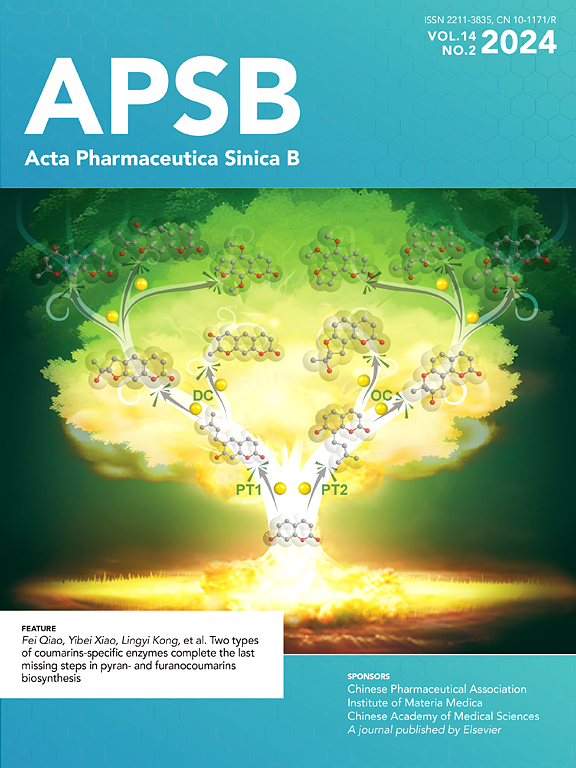心理应激激活的NR3C1/NUPR1轴促进卵巢肿瘤转移
IF 14.6
1区 医学
Q1 PHARMACOLOGY & PHARMACY
引用次数: 0
摘要
卵巢肿瘤(OT)是妇科恶性肿瘤中最致命的形式,在过去的几十年里,患者的预后几乎没有改善。转移是卵巢癌相关死亡的主要原因,但其潜在机制尚不清楚。已知心理应激可激活糖皮质激素受体(NR3C1),这是OT患者预后不良的一个因素。然而,连接NR3C1信号和转移的确切机制尚未完全阐明。在这项研究中,我们证明慢性抑制应激通过涉及核蛋白1 (NUPR1)的nr3c1依赖机制加速OT的上皮-间质转化(EMT)和转移。从机制上讲,NR3C1直接调控NUPR1的转录,从而增加蜗牛家族转录抑制因子2 (SNAI2)的表达,SNAI2是EMT的关键驱动因素。临床上,OT患者NR3C1升高与NUPR1表达呈正相关,且两者均与预后不良呈正相关。总的来说,我们的研究发现NR3C1/NUPR1轴是心理应激诱导的OT转移的关键调控途径,提示干预OT转移的潜在治疗靶点。本文章由计算机程序翻译,如有差异,请以英文原文为准。

Psychological stress-activated NR3C1/NUPR1 axis promotes ovarian tumor metastasis
Ovarian tumor (OT) is the most lethal form of gynecologic malignancy, with minimal improvements in patient outcomes over the past several decades. Metastasis is the leading cause of ovarian cancer-related deaths, yet the underlying mechanisms remain poorly understood. Psychological stress is known to activate the glucocorticoid receptor (NR3C1), a factor associated with poor prognosis in OT patients. However, the precise mechanisms linking NR3C1 signaling and metastasis have yet to be fully elucidated. In this study, we demonstrate that chronic restraint stress accelerates epithelial–mesenchymal transition (EMT) and metastasis in OT through an NR3C1-dependent mechanism involving nuclear protein 1 (NUPR1). Mechanistically, NR3C1 directly regulates the transcription of NUPR1, which in turn increases the expression of snail family transcriptional repressor 2 (SNAI2), a key driver of EMT. Clinically, elevated NR3C1 positively correlates with NUPR1 expression in OT patients, and both are positively associated with poorer prognosis. Overall, our study identified the NR3C1/NUPR1 axis as a critical regulatory pathway in psychological stress-induced OT metastasis, suggesting a potential therapeutic target for intervention in OT metastasis.
求助全文
通过发布文献求助,成功后即可免费获取论文全文。
去求助
来源期刊

Acta Pharmaceutica Sinica. B
Pharmacology, Toxicology and Pharmaceutics-General Pharmacology, Toxicology and Pharmaceutics
CiteScore
22.40
自引率
5.50%
发文量
1051
审稿时长
19 weeks
期刊介绍:
The Journal of the Institute of Materia Medica, Chinese Academy of Medical Sciences, and the Chinese Pharmaceutical Association oversees the peer review process for Acta Pharmaceutica Sinica. B (APSB).
Published monthly in English, APSB is dedicated to disseminating significant original research articles, rapid communications, and high-quality reviews that highlight recent advances across various pharmaceutical sciences domains. These encompass pharmacology, pharmaceutics, medicinal chemistry, natural products, pharmacognosy, pharmaceutical analysis, and pharmacokinetics.
A part of the Acta Pharmaceutica Sinica series, established in 1953 and indexed in prominent databases like Chemical Abstracts, Index Medicus, SciFinder Scholar, Biological Abstracts, International Pharmaceutical Abstracts, Cambridge Scientific Abstracts, and Current Bibliography on Science and Technology, APSB is sponsored by the Institute of Materia Medica, Chinese Academy of Medical Sciences, and the Chinese Pharmaceutical Association. Its production and hosting are facilitated by Elsevier B.V. This collaborative effort ensures APSB's commitment to delivering valuable contributions to the pharmaceutical sciences community.
 求助内容:
求助内容: 应助结果提醒方式:
应助结果提醒方式:


